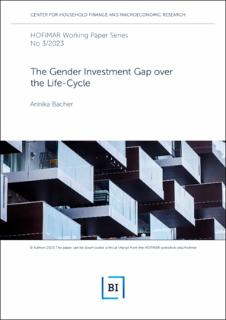| dc.contributor.author | Bacher, Annika | |
| dc.date.accessioned | 2024-04-04T15:09:58Z | |
| dc.date.available | 2024-04-04T15:09:58Z | |
| dc.date.issued | 2023 | |
| dc.identifier.issn | 2704-1980 | |
| dc.identifier.uri | https://hdl.handle.net/11250/3124932 | |
| dc.description.abstract | Single women hold less risky financial portfolios than single men. This paper analyzes the determinants of the “gender investment gap” based on a structural life-cycle framework. The model is able to rationalize the investment gap without introducing gender heterogeneity in preferences (e.g. in risk aversion). Rather, lower income levels and larger household sizes of single women are the main determinants for explaining the gap. Importantly, expectations about future realizations of both variables (that cannot easily be controlled for in regressions) drive most of the investment differences for young households whereas heterogeneity in observable characteristics explains the gap later in life. | en_US |
| dc.language.iso | eng | en_US |
| dc.publisher | BI Norwegian Business School | en_US |
| dc.relation.ispartofseries | HOFIMAR Working Paper Series;3/2023 | |
| dc.subject | Household Finance | en_US |
| dc.subject | Life-Cycle | en_US |
| dc.subject | Gender | en_US |
| dc.subject | Portfolio Choice | en_US |
| dc.title | The Gender Investment Gap over the Life-Cycle | en_US |
| dc.type | Working paper | en_US |
| dc.source.pagenumber | 68 | en_US |
